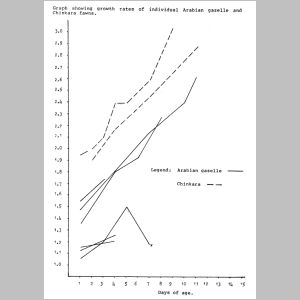Bulletin 25 - March 1985: Preliminary Observations on the Growth Rates of Neonatal Gazelles
Preliminary Observations on the Growth Rates of Neonatal Gazelles
by C.W. Furley*This study presents the first results of a continuous study of weight increase in newly born gazelles. The fawns are weighed, using scales when possible (i.e. before they are unable to be caught), beginning at age 24 hours. The graph shows the results for two species, the Arabian gazelle (Gazella gazella cora, formerly Gazella gazella arabica) and the Chinkara or Indian gazelle (Gazella dorcas bennetti).
Six fawns from the Arabian gazelle herd were weighed and two from the Chinkara group. These herds are maintained at Al Ain Zoo in captivity. All fawns were fed by the natural mothers, and the period during which weights were measured (the first 15 days of life) means that all fawns were still suckling milk.
The results, depicted on the graph, clearly show that growth rates in both species is very rapid. Although the individual animals are not marked on the graph, daily growth rates for these fawns were calculated.
| Arabian gazelles | Chinkara |
| 0.112 kg | 0.108 kg |
| 0.004 | 0.06 |
| 0.016 | |
| 0.132 | |
| 0.127 | |
| 0.115 | |
| 0.085 |
These figures should not be taken as markedly accurate, as information is sparse at the present time. However, they do show a wide variation in the daily weight gain by neonatal gazelles. Several reasons for this may be offered: human error in the weighing process resulting in false readings; variation in the time of day when the animals were measured resulting in some animals being weighed in the morning, after the night feed, and some in the late afternoon; and movement of the animal when on the scales makes accurate reading difficult.
The animal marked X on the graph thrived well for 5 days, then became ill and died suddenly, hence the loss in weight.
Chinkara are heavier gazelles than Arabian gazelles, and the differences in birth weight reflect this. Both Chinkara fawns were heavier at 24 hours than any of the Arabian gazelles. The rates of growth shown by the steepness of the lines on the graph for both Chinkara and the two Arabian gazelles which were weighed for more than 7 days are very similar.
The results presented here are the first such for both of these species, either in captivity or in the wild. Results from wild gazelles may indicate that growth is less rapid due to adverse environmental conditions which may affect the health of the mother, but there is no information about this available. The study will be updated when sufficient information has been collected.
* BVM & S, MRCVS, FZS
Al Ain Zoo,
P.O. Box 1204, Al Ain
Return to top
